No matter your preferred type of exercise, stretching and warming up can help loosen tight muscles, increase your blood circulation, and reduce your risk of injuries. Runners, sprinters, and athletes can spend several minutes or longer warming up for a race or game. I love a good stretch in the morning or when I’m winding down for bed. When I had only learned a few yoga poses as a beginner, I would have the urge to do these poses at several random times and places throughout the day because I wanted to stretch and move my body.
Animals naturally stretch their muscles, from wild animals to pet dogs and cats. One of the best stretches in our full-body stretching list is the downward dog, a yoga pose. The name “downward dog” came from the natural stretching behavior where dogs stretch their hind legs. You don’t have to be a runner or an athlete to include stretching in your day. If you’re sitting at a desk for hours, a simple triceps stretch could help you feel a little better, and your muscles will thank you. We’ve selected the best full-body stretching routine.
What are the benefits of stretching?

You don’t have to spend lots of time stretching to get the benefits. The following are some of the numerous benefits of stretching:
- Increase flexibility.
- Promote muscle recovery and relaxation.
- Reduce your risk of injury.
- Lower your stress.
- Loosen and elongate tight, constricted muscles.
- Improve blood circulation and blood vessel function.
- Warm up your tissues and bring blood flow to the muscle groups before you exercise.
- Research reveals stretching can increase your range of motion, especially when it comes to hamstrings.
- An interesting study concluded that an eight-week stretching and strengthening routine can reduce pain associated with poor posture.
- Research shows that performing dynamic stretches before working out could improve athletic performance and reduce joint restrictions.
- Stretching after a workout assists your body in returning to the pre-exercise state.
- Reduce post-exercise muscle soreness and stiffness.
When is the best time to stretch?

There are different times to stretch and different ways of stretching. Many stretches are simple, and you can do them while watching TV or at work. Most importantly, you should elongate your muscles when it feels good for you and when you’re most likely to do it.
Dynamic stretches involve moving your muscles or joints through the full range of motion, such as leg swings or arm circles. These help warm your muscles up and prepare them for exercise. Static stretches like the plank or cobra involve not moving and holding certain poses or stretches for at least 15 seconds or longer. Static stretches are an excellent choice after exercise.
Before exercise
You might perform better with warm muscles than cold muscles, so adding the right stretching moves to your warmup routine can prepare your muscles for your upcoming workout sesh.
After exercise
Stretching after an intense workout could reduce muscle soreness and stiffness. Stretching after a workout or a bath when your muscles are warm could help your body return to its pre-exercise state.
After sitting

If you’ve been sitting down for some time, stretching can prompt more blood flow to your muscles and reduce stiffness. This is one of the reasons why stretching feels good when you wake up or when you get up after a long period of inactivity.
Before bed
A study concluded that static stretching activates your parasympathetic nervous system, which helps your body rest, digest, and relax. This could be why stretching before bed helps many people feel more relaxed and de-stress after a long day.
How to incorporate a full-body stretching routine

You might want to give certain muscles extra attention if they feel especially constricted. People who spend lots of time sitting might have muscle tension in their neck, lower and upper back, hips, and legs. Target specific muscles and muscle groups by performing multiple stretches, holding that stretch longer, or doing it multiple times until you feel sufficient relief. You should avoid any movements that cause you sudden or sharp pain. Stretching can be mildly uncomfortable, but it shouldn’t be painful.
Without further ado, let’s start elongating those muscles and moving those joints. This full-body stretching routine shouldn’t take you more than 10 to 12 minutes to complete. Try holding each stretch for 10 to 30 seconds and repeat it one to three times.
Legs and lower body
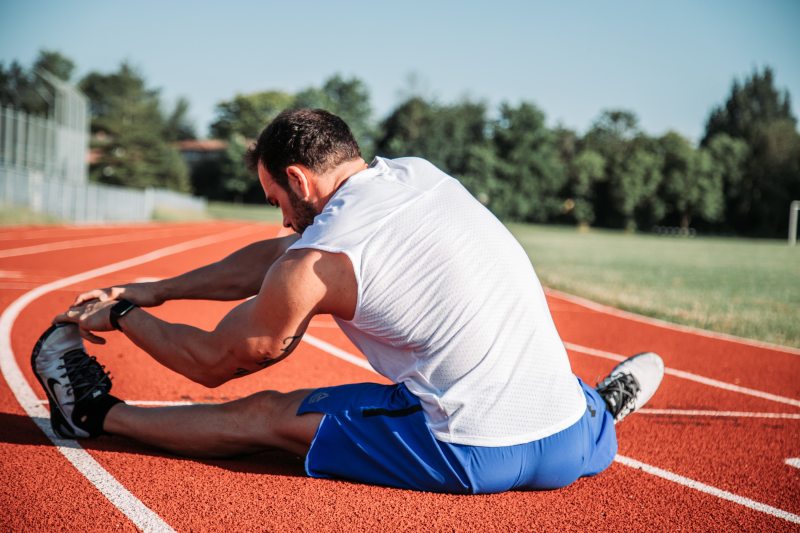
Let’s start by stretching your legs and lower body to increase circulation and loosen some of the largest muscles in your body. Begin with simple ankle rolls before moving on to the next stretches for your lower body.
Calves

The calf raise is one of the best stretches for your calves. You can use a step or a slope for this move.
Here’s how to do standing calf raises on an exercise step:
- Stand upright on a weight plate or exercise step. Make sure you’re standing on the balls of your feet with your toes and the front of your feet resting up on the exercise step.
- Engage your core and calves, and raise your heels off the floor as high as you can.
- Slowly lower your heels back down to the starting position.
Hamstrings
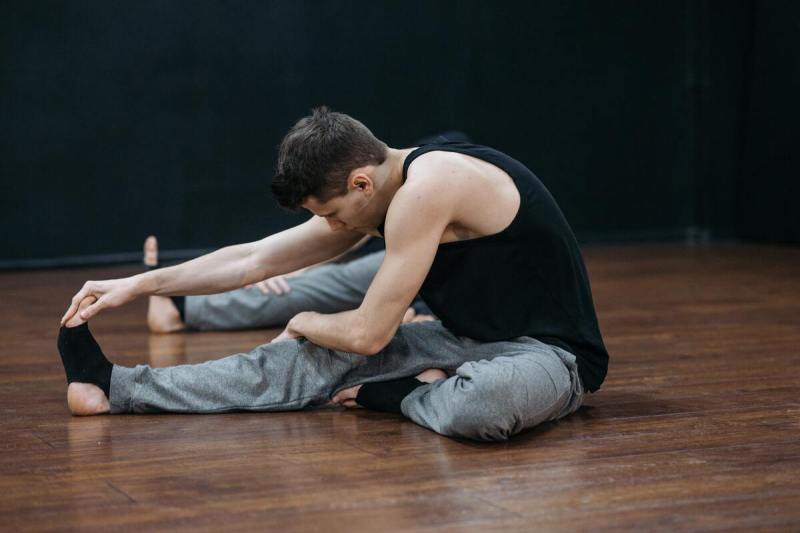
Your hamstrings are the large leg muscles on the back of your thighs that help you walk, climb stairs, perform squats, and more. Hamstring injuries are common in sports, so stretching these muscles is important.
Here’s how to do a seated hamstring stretch:
- Sit on a soft surface like a yoga mat and place one leg out in front of you. Your other foot can rest against the inner thigh of your extended leg.
- Keep your back straight and lean forward as if you’re reaching for your toes.
- You’ll feel a stretch on those hamstrings at the back of your legs.
- If you can’t touch your toes, just rest your hands on the floor next to your leg.
- Hold the pose for 30 seconds.
- Gently bring yourself back to the starting position.
- Repeat with your other leg.
Quads
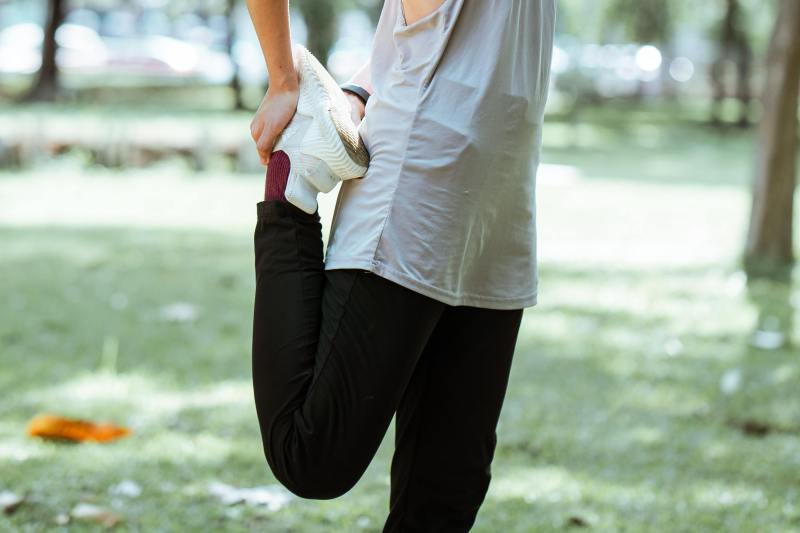
Your quadriceps are the large muscles at the front of your thighs. Stretching your quads is important for runners as these large muscles often become tight from running or performing certain exercises and sports.
How to do a standing quad stretch:
- From a standing upright position, bring your right foot up to your butt behind you and hold it in place with your right hand.
- You’ll need to maintain your balance on your standing leg. If needed, you can hold onto a solid structure or wall with your other hand for stability.
- Tuck your pelvis under and keep your knee pointing down to the floor.
- Hold the pose for 30 seconds.
- Repeat with your other leg.
Leg swings

Leg swings are an excellent way to finish off your leg stretches. Start with smaller swings, and you can do bigger swings as your muscles begin to warm up. You’ll increase blood flow to your legs and get a good stretch in your glutes, hips, and inner thighs.
How to do leg swings:
- Start standing upright with your feet about shoulder-distance apart.
- Shift your weight on your left leg and swing your right leg in a pendulum motion back and forth in front of and behind your body.
- Only swing your right leg as far as you feel comfortable, and try to maintain your balance with your weight evenly distributed on your left foot.
- Aim for 20 reps.
- Switch to the other side.
Glutes

You’ll also feel this glute stretch in your hips and deep piriformis muscle, which is often tight in athletes and active people who play sports with lots of repetitive motions and sharp turns. You might prefer to lie on a soft mat.
How to do the glute stretch:
- Lay on your back and bend your knees while keeping your feet flat on the floor.
- Lift your right foot off the floor and try to form a 90-degree angle with your leg so your shin is parallel to the ground.
- You can rest your right ankle on your left thigh.
- You’ll feel your hip rotate outward.
- Hold behind your left thigh and pull your left leg into your chest.
- Hold the pose for at least 30 seconds.
- Return to the starting position.
- Repeat the movement on the other side.
Upper body

Now, you can start stretching your upper body, including your chest, shoulders, back, and arms. You’re always using your arms every day whether or not you’re working out. Your back also does a lot of work, so warming up these large muscles is especially beneficial.
Chest

The following move will stretch your shoulders and open up your chest muscles. Before you try this move, if your shoulders are particularly constricted, you can take your arms behind you and mimic an airplane by taking them out to the sides. Next, you can try the chest and shoulder stretch.
Here’s how to do the chest and shoulder stretch:
- Stand or sit and clasp your hands together behind your back.
- Keep your arms straight.
- Carefully lift your hands up toward the ceiling only as much as you feel comfortable.
- Hold the pose for 15 to 30 seconds.
- Try to repeat this stretch two or three times.
Lower back
Knee-to-chest stretch

The knee-to-chest stretch is one of the most superior for elongating your lower back muscles to provide some relief. You can do this move standing or lying down on a yoga mat.
Here’s how to do the knee-to-chest stretch:
- Lie on your back on a soft mat with both legs extended flat on the floor.
- Slowly bend your right knee to bring your right knee toward your chest.
- You can use both hands to help pull your knee toward your chest and hold it there for a moment.
- Slowly return your right knee to the starting position.
- Repeat with your left leg.
Upward-facing dog

Upward dog is a yoga pose that works your chest and abdominal muscles and strengthens your shoulders, triceps, forearms, and lower back. Lots of people use this pose to help relieve lower back pain.
Here’s how to do upward dog:
- Start laying on your stomach with your forehead down and your hands by your lower ribs.
- Press down with your hands and feet and lift your chest forward and up.
- Draw your shoulders back and make sure your neck is in line with the curve of your upper back.
- Use your hands, arms, and feet to slowly bring your chest and forehead back down to the ground.
Upper back
Child’s pose

Child’s pose is a relaxing yoga move that stretches your lower back muscles, hips, and inner thighs. Modify by adding pillows if it feels better for you.
How to do child’s pose:
- Come down to your hands and knees on a yoga mat.
- Spread your knees as wide as your mat while keeping the tops of your feet resting on the floor and your big toes together in the starting position.
- Lean forward to rest your stomach between your thighs and place your forehead near the floor or as low as you can.
- You can place your arms where it feels best for you, but most people prefer to extend their arms straight out above your head on the mat.
- Hold the pose before slowly bringing yourself back up to the starting position.
Seated twist stretch

The seated twist stretch might also be called the seated oblique twist because it’s a killer workout for your obliques. You’ll also develop rotational strength and stretch your back muscles. You can try this move on the floor, bench, or chair.
How to do a seated twist:
- Sit on a bench or chair with your feet on the floor.
- Keep your feet and your knees about hip-width apart.
- Lengthen your spine and keep your shoulders rolled back.
- Keep your core muscles engaged throughout this exercise.
- Twist your torso toward the right and place your right hand on the back of the chair.
- Place your left hand outside your right thigh and try to deepen the twist.
- Turn your head to look over your right shoulder and hold the position.
- Return to the starting position and repeat on the other side.
Arms
Overhead triceps stretch

You can try this exercise standing or sitting. It’s one of the most well-known triceps stretches.
How to do an overhead triceps stretch:
- Straighten your right arm up toward the ceiling and then bend your elbow to bring the palm of your right hand to the middle of your back between your shoulder blades. Aim to rest your middle finger down your spine.
- Use your left hand to gently push your elbow more into the middle and down.
- Hold the stretch for 30 seconds.
- Shoot for three or four reps on each side.
Modification: You can make it easier if you can’t reach your hand to the middle of your shoulder blades or back; just place it on the back of your head instead.
Bicep stretch
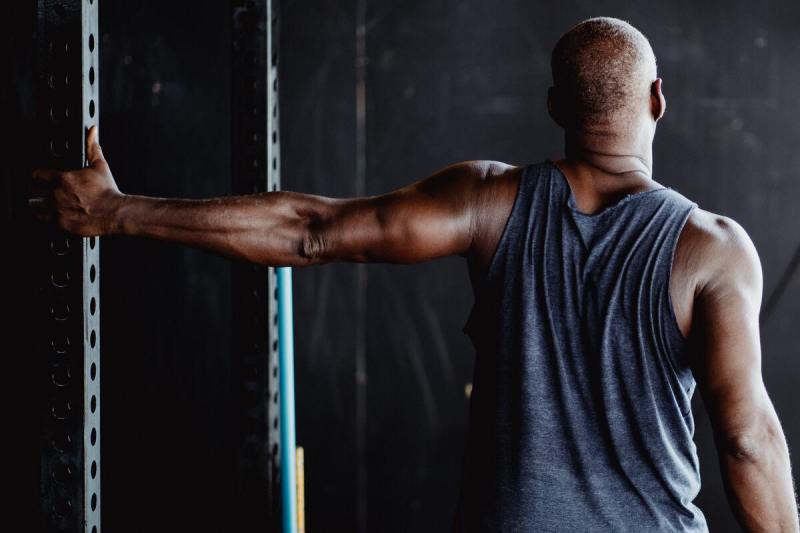
This bicep stretch also opens up your chest; all you need is a wall.
How to do a bicep wall stretch:
- Stand next to a wall with your left arm out straight and your hand resting on the wall.
- Bring your arm out to the side and slightly behind you. Keep your hand on the wall while you rotate your whole body away from the wall until you feel the muscles in your biceps and chest elongating.
- Hold for about 15 to 30 seconds.
- Repeat the movement one to three times.
- Repeat with your other arm.
Neck and shoulders

Finish off with some shoulder and neck rolls. Roll your shoulders around in a full circle several times. Now, do the same with your neck. Other excellent moves to finish off your full-body stretching routine include downward dog, arm circles, pigeon pose, and the runner’s lunge.
Closing thoughts
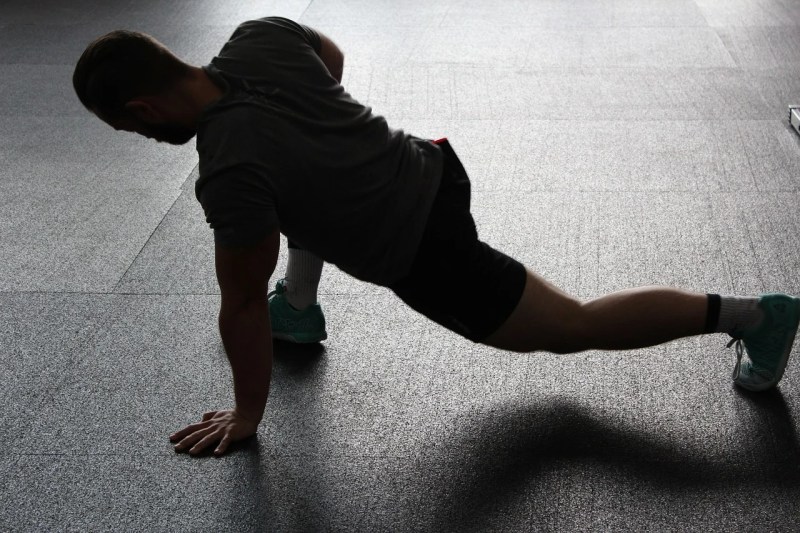
If you’re unsure what stretches are suitable for you, consult your personal trainer, physical therapist, or healthcare provider. A good full-body stretching routine should have at least one stretch for every major muscle group, like this example from yoga instructor and fitness buff Travis Eliot, who guides you through a range of stretches and poses.
If you’re prepping for a good workout, this 10-minute full-body stretching routine from fitness buff Alex Crockford is worth doing. There are plenty of reasons to start stretching regularly, especially if you work out. You can improve your range of motion, circulation, and athletic performance and lower your risk of injury. Aim for at least one stretch targeting each major muscle group.




